To meet the Paris Agreement’s goal of limiting global temperature rise to below 1.5°C, cost-effective measures for accelerated transitions toward greenhouse gas (GHG) neutral energy systems are required. In all plausible scenarios, achieving climate neutrality in the second half of this century while ensuring energy security is a major challenge that cannot be addressed by excluding any technology, as this would restrict flexibility and increase transition costs. Nuclear energy is a proven, mature, and essentially zero GHG-emitting technology that can provide the base-load electricity needed to ensure 24-hour stability in electric grids with an increasingly renewable supply.
Challenge
Governments currently face the challenge of mitigating climate change amid visible impatience, especially among civil societies and youth, calling for resolute, coherent multilateralism to limit the increase in global temperatures to below 1.5°C as established in the Paris Agreement on climate action, in the context of the 2030 Agenda for Sustainable Development. There is an urgent need for informed, evidence-based policies and the implementation of cost-effective measures for accelerated transitions toward energy systems characterized by greenhouse gas (GHG) emissions neutrality. In all plausible scenarios, achieving climate neutrality in the second half of this century while ensuring energy security is a major challenge that cannot be addressed by a single solution. Hence, the importance of assessing all low-emissions technologies and pathways as a part of a global response portfolio cannot be overstated, as any technology exclusion typically restricts flexibility and increases costs.
While deploying nuclear power is favorable from the climate perspective, socio-political, economic, and strategic concerns continue to exist, most notably, public perceptions dominated by safety concerns; security, including cybersecurity and terrorist threats; and spent nuclear fuel (SNF) disposal. To address these concerns, it is necessary to raise public awareness of current nuclear plants’ proven safety record and the advanced disposal preparations for SNF, as well as the additional safety, security, and SNF management benefits offered in the newer generation of nuclear designs. This generation of advanced nuclear power plant technologies, including so-called “small modular reactors” (SMR), must also address the new market and infrastructure challenges posed by the structural changes from the climate-constrained energy transition.
The overarching challenge is to promote national policies and multinational cooperative activities to support the global expansion of safe, secure, strictly regulated, and economically viable nuclear energy. This is particularly important in newcomer countries where much of the nuclear energy expansion may occur. This policy brief proposes key requirements that would enable nuclear energy to “to attain an increasing share” in the global energy mix, and thus, contribute to climate protections and energy systems’ increased resilience in all countries. All low-emissions energy technologies and pathways must be assessed as a part of any global response strategy toward GHG neutrality. Thus, the following criteria are needed to ensure a “level playing field” when determining the most appropriate electricity-producing technologies:
- generating capacity that can be implemented in the required timeframe,
- the generation system’s grid compatibility,
- operational safety of plant and associated energy system components,
- impacts on human health and security,
- environmental aspects, including emissions, land, and water use, and SNF management issues,
- economics on a full life cycle basis,
- resilience toward major natural and anthropogenic hazards, including cyberattacks, and
- sustainability of the energy resource.
Nuclear power compares well against alternative low-emission technologies across all criteria.
Proposal
Proposal I
Any energy transition requires strong G20 endorsement of the policies and measures supporting the implementation of low-emissions energy systems. Any combination of technologies considered must include nuclear energy. This requires support for existing plants’ license extensions, the construction of new plants, and the development and implementation of advanced technologies, including SMRs. All G20 countries should also support research, pilot projects, and educational activities to heighten the recognition of nuclear energy’s positive contributions, including climate mitigation.
Why nuclear energy is essential in the energy mix
In 2019, 443 nuclear power plants operating in 31 countries contributed 2,563 terawatt-hours (TWh) (10.2%) to the global electricity supply, or 28.4% of the world’s low-carbon electricity (IAEA 2019b, 2020a; International Energy Agency—IEA 2019a). In all pathways to 1.5°C in the special report of the Intergovernmental Panel on Climate Change (IPCC 2018), renewables provide the bulk of electricity generation by 2050. However, the 1.5°C target also depends on the large-scale utilization of carbon dioxide removal (CDR) technologies (IPCC 2018). Most IPCC scenarios also show increasing shares of nuclear energy as well as fossil fuels with carbon capture and storage (CCS). Without the assumed expansion of nuclear electricity, an additional 5.5 gigatons (Gt) of carbon dioxide (CO2) emissions would occur if replaced exclusively by state-of-theart coal-generation technologies without CCS or CDR, or 2.9 Gt, if replaced by natural gas. Further, CDR technologies are unproven yet and would be required to operate at rates of two Gt/CO2 per year or more. Expanding proven nuclear energy can readily provide all of these CO2 benefits if CDR technologies are insufficiently implemented.
Nuclear energy compares well with other grid-scale electricity-generating options in terms its safety, environmental friendliness, cost effectiveness, and sustainability. The debate on the potential extent of its contribution to mitigating climate change is not primarily technical, but driven by socio-political, economic, and strategic issues, and by public perceptions and fears over safety, security, and SNF disposal.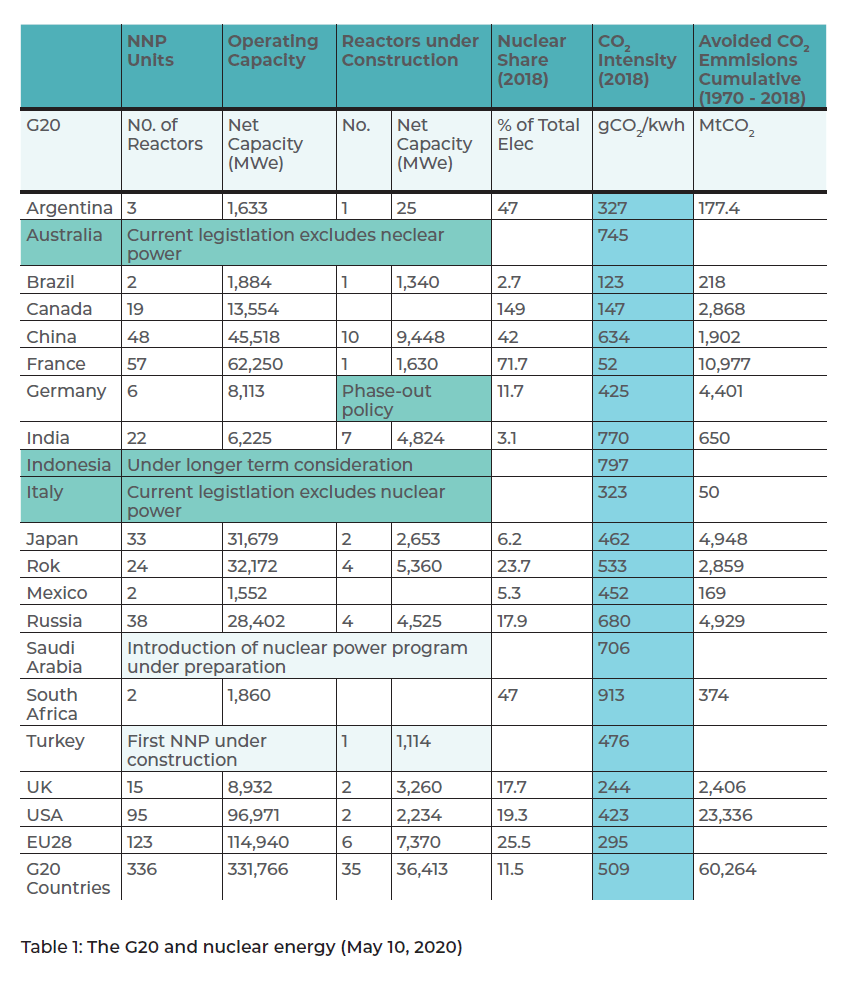
Table 1 indicates that G20 countries with a high share of nuclear electricity have avoided significant CO2 emissions. Currently, 14 of the 19 individual G20 member countries operate nuclear power plants. Two G20 countries are considered newcomers: Turkey is constructing its first NPP, and Saudi Arabia is actively preparing to introduce its first NPP. Other non-G20 countries are also constructing or preparing for the introduction of nuclear power. On the other hand, Australia and Italy have legislation in place that bans the use of the technology, while Germany has established a policy to phase out all NPPs by the end of 2022. The outlook for the remaining 15 G20 countries varies, as 11 are actively constructing new NPPs but these programs in the long-term will remain subject to national policies, public support, alternative options, and market conditions. Several governments support NPPs but seek private-sector participation for new nuclear energy pursuits given the high financing necessary, which consequently reflects a tacit preference for SMRs. Other jurisdictions prioritize license extension of their existing NPP fleet as a way forward, while awaiting SMRs’ commercialization.
Environmental, resource, and health aspects
- GHG emissions: On a life cycle basis, nuclear electricity emits minimal GHG and other harmful pollutants per kilowatt-hour (kWh). Emissions are comparable with renewable electricity chains and outperform fossil generation (without CCS) by one to almost two orders of magnitude (Figures 1 and 2).
- Land use: Utility-type solar systems and wind farms need approximately 300 to 500 times as much land as a nuclear plant of the same capacity.
- Health effects: Nuclear, wind, and small hydroelectric plants pose the lowest health risks per unit of electricity output (Figure 3). The two major nuclear accidents, Chernobyl and Fukushima, resulted in widespread contamination, hundreds of billions of US dollars in economic damages, health impacts, and fatalities from evacuation-relocations; yet either no- or very limited- immediate radiation-caused fatalities, and the diverse estimates of long-term effects are likely to be unobservable.
- Spent nuclear fuel: Another challenge involves implementing SNF disposal facilities in regions, states, or communities willing to host such repositories. Technically, the broad consensus is that a repository can be implemented safely and represents only a minor component of generation costs. Deep geologic disposal is the official policy of all G20 member states. Some repositories will be in operation in a few years, but many have been delayed for various reasons, most of which are nontechnical. Further, countries may not need to develop their own repositories, as a G20 endorsement of multi-national repository initiatives and fuel take-back approaches to spent fuel management can help overcome the challenges that exist.
- Grid reliability and flexibility: The variable nature of wind and solar energy requires a complementary base-load electricity supply. Hydraulic and battery storage cannot supply all the GWe that will be needed if wind and solar power levels dropped substantially for several days. Some advanced NPP designs offer economic electricity that can be dispatched to follow grid requirements, as they vary over relatively short time intervals to complement large NPPs’ base-load capabilities. Hence wind, solar, hydro, and NPPs, collectively, can provide all the electricity needed in a carbon-neutral energy system. NPPs deserve objective consideration on a levelized playing field.
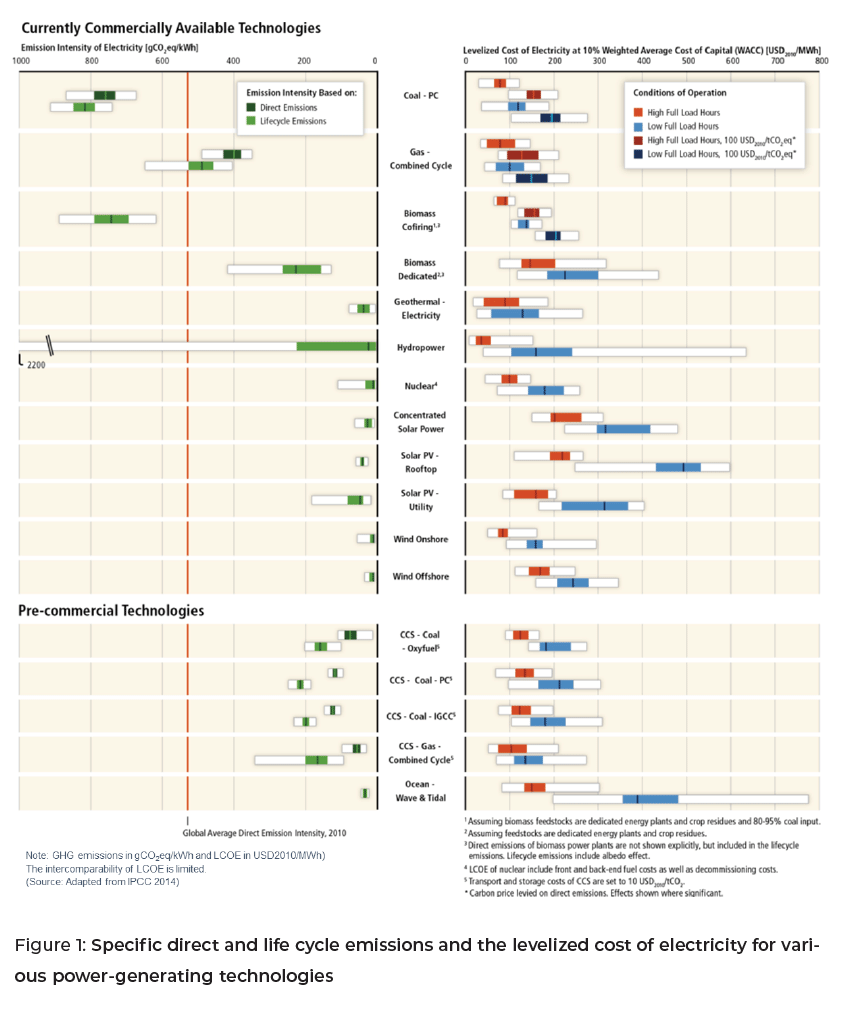
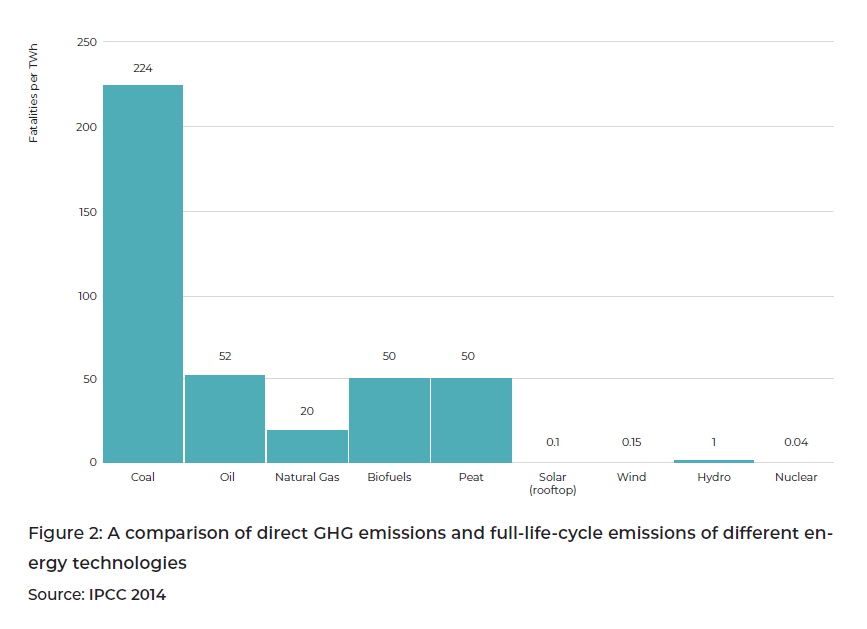
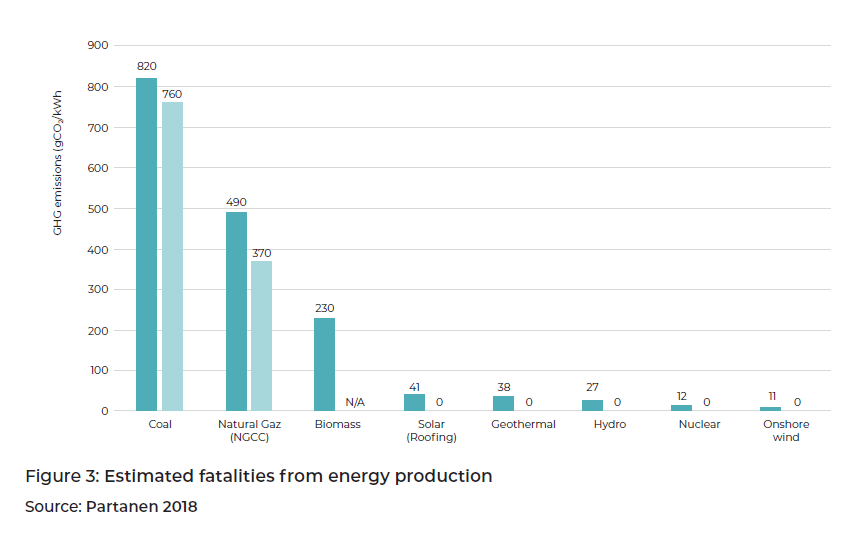
Economic aspects
Although NPPs are expensive to build and finance, they are inexpensive to operate. Many countries’ projected levelized cost of nuclear electricity (LCOE) can be lower than that of fossil fuels, if CO2 mitigation costs are considered. NPPs can also be competitive with many renewable energy technologies on a 24/7 dispatchable basis (see Figure 1). However, the LCOE is not the only factor determining an energy source’s economic viability. Specifically, nuclear energy’s LCOE value accounts for the high absolute upfront investment and interest costs during the long lead time before a new nuclear plant earns revenue, as well as the decades during which the plant will produce electricity at predictable, stable costs. However, these factors are hidden within an LCOE value that must be used with caution, especially when comparing it with another technology’s LCOE (see Figure 1). In any transition to a carbon-neutral future, nuclear energy has the largest mitigation potential with favorable costs of emissions avoided ($/tCO2).
High capital requirements and long amortization periods are often viewed as too risky by private sector entities and pose problems in securing the necessary financing. Firstof-a-kind nuclear designs often encounter construction delays and cost overruns, issues that are usually overcome through technology learning, as actual investment in new nuclear designs provides experience that leads to cost reductions (see Figure 4). Valuing the climate benefits, reliability, and dispatchability of nuclear electricity has prompted some national governments to provide financing support directly or indirectly. For example, by introducing investor risk-reduction measures such as regulated asset base funding, and contracts for difference or capacity markets.
License extension of existing NPPs, in full compliance with all safety regulations, is one of the least-cost supply-side GHG mitigation options available. However, this requires governments to make the climate benefits of nuclear energy visible to investors by monetizing avoided emissions and creating level playing fields in liberalized markets dominated by cheap natural gas and subsidized renewables. Over the past 50 years, the use of nuclear power has avoided more than 60 Gt CO2 emissions. Lack of further lifetime extensions of existing nuclear plants could result in an additional 4 Gt of emitted CO2 emissions. Many reactors around the world have applied for and received license extensions to operate for a total of 60 years, and in the USA sometimes for 80 years.
Political decisions and public opinion directly affect technical choices
National energy strategies are often based not on a rational, objective analysis of costs, environmental aspects, or safety—among other factors—but on political decisions often driven by public opinion and the lobbying efforts from the supporters of particular technologies.
The impacts of the two major nuclear accidents (Chernobyl and Fukushima) on public and political opinion, while huge, have declined with time. Currently, countries expanding, maintaining, or introducing nuclear power programs outnumber those deciding to phase out or not introduce nuclear power.
A major justification for the continued or expanded interest in nuclear power is its potential contribution to combating climate change. Nevertheless, political opinion and opposition have led to nuclear power’s exclusion from funding mechanisms supporting a transition to low-carbon electricity generation (European Commission— EC 2020).
Proposal II
All G20 countries should share best practices with all countries operating nuclear facilities, and encourage newcomers to follow the IAEA’s “Milestones” approach to assess the readiness of their infrastructure to comply with the highest standards of nuclear safety, security, and non-proliferation. It is also necessary to develop back-end SNF management strategies that conform to the requirements of the Joint Convention on the Safety of Spent Fuel Management and the Safety of Radioactive Waste Management (IAEA 1997). A G20 endorsement of multi-national repository initiatives and fuel take-back approaches to spent fuel management would particularly benefit newcomer countries. Further, G20 countries should assist in mobilizing finances, transferring technology transfer, and building capacity in developing countries where a national nuclear energy program could demonstrate verifiable climate benefits.
Newcomer and developing country issues
The introduction of nuclear energy in developing countries has been advocated to reduce GHG emissions, alleviate energy security concerns, and increase energy access. However, several challenges must be addressed for newcomers, ranging from establishing a skilled nuclear work force and safety culture to addressing nuclear infrastructure prerequisites and proliferation concerns. The IAEA “Milestones” approach provides guidance to newcomer countries aiming to initiate nuclear energy programs (IAEA 2015). This approach is a phased, comprehensive process that includes preparing a legal framework to govern all activities related to nuclear materials, technology, and ionizing radiation, and establishing an independent nuclear regulatory body responsible for nuclear safety, radiation protection, and ensuring compliance with the regulatory framework (outlined in the next section). Newcomer countries can also benefit if the G20 and other advanced nations commit to facilitating and supporting global cooperative approaches to nuclear fuel cycles, and particularly SNF management, including fuel take-backs and developing multinational repositories. Another critical component of the IAEA’s approach involves developing human resources in all operational aspects of nuclear energy. It is also important to engage stakeholders in every stage of nuclear projects to address any issues related to public acceptance and perception. Transparent, fact-based communications can enhance the public’s understanding of nuclear energy’s safety and security.
The financing issue is crucial for countries wishing to introduce or expand nuclear power. This may be eased by the introduction of SMRs (described below). For any nuclear new build, however, the financing hurdle could be reduced by, for example, investments by state-owned companies, government backed loans, price guarantees, etc.
International cooperation is also important in assuring coordinated review and approval of new NPP designs by national regulatory agencies. This makes it easier for companies designing these reactors to enter global marketplaces while meeting international standards. Activities to achieve this regulatory coordination are already underway but need the endorsement of the G20.
Proposal III
The IAEA should be empowered by the G20 to gradually assume the role of international regulator; the G20 should work with other countries and the IAEA towards depoliticizing nuclear energy by endorsing global norms, policies, and practices. This includes moving to mandatory international inspections and oversight, thus decreasing the global risk of a major accident.
International regulation
Nuclear safety regulations are the responsibility of the national jurisdiction in which a nuclear facility operates. Therefore, safety standards, regulations, enforcement, and safety cultures vary among countries, which is of concern. The IAEA has sponsored safety conventions, continuously disseminated best practices to its members, and dispatched safety review missions upon a member state’s request to inspect local nuclear facilities or review the country’s nuclear regulatory agency.
However, the IAEA has no mandate to enforce safety regulation. The proposal here involves modifying and broadening the IAEA’s role. While enforcement would remain the individual country’s responsibility, mandatory international inspections and oversight are recommended as a mechanism for identifying weak performance or other safety concerns and disseminating best practices. This would bring significant increase in global confidence that a major accident and its associated social and economic costs will not occur. An international regulator might also pave the way for an international insurance fund to cover major accident costs. These decreased economic and financial risks will improve NPPs’ competitiveness.
Some international instruments toward these objectives already exist, the most important of which is the international Convention on Nuclear Safety established in the mid-1990s. However, this convention is “quasi-voluntary,” with no power to require nations’ cooperation. Even if international enforcement measures such as imposing sanctions remain beyond reach, compulsory inspection and oversight can provide a vital international “check” on poor safety performance.
Proposal IV
G20 countries are best positioned to support the development and implementation of advanced reactors and fuel cycles, including SMRs, in countries that opt for introducing, continuing or expanding the use of nuclear energy, provided that they uphold the highest standards of safety, security, SNF disposal, and non-proliferation. All G20 countries should coordinate and support research, development, and demonstration toward the early commercialization of innovative SMR designs. Thus, G20 countries should initiate the development of user requirements covering both G20 and newcomer countries. These would help focus commercialization efforts on a manageable fraction of the more than 50 designs under development today. Finally, the G20 should support standardized licensing criteria for SMRs, which would reduce the time and cost to commission new units.
Small modular reactors (SMRs)
Commercially available nuclear reactor designs ranging from 1,000 to 1,600 MWe in size must be supplemented by smaller unit designs – so called SMRs of 20 to 300 MWe (IAEA 2018). These SMRs are better suited to balance the baseload in largely renewable systems, integrate with smart grids, provide energy services other than electricity, and supply electricity in remote or developing regions with small or weak grids. Most SMR designs are also significantly safer. Rather than competing with renewables,
SMRs could support their increased market penetration by compensating for their variability, as they can support grid modernization—such as through smart grids or load growth—and help replace existing aging infrastructure (Economic and Finance Working Group—EFWG 2018).
Further, SMRs are expected to mitigate several of the key challenges in using large reactors. For example, SMRs present a lower investment risk, as reactors with fewer MWe per unit require less up-front capital per unit, which enables easier financing. The SMRs designed in the lower MWe range allow fabrication and delivery to the generation site instead of on-site construction, thus reducing the risks of project delays and excessive cost overruns.
Despite the lower upfront capital costs of SMRs per unit, the specific investment costs per kWe installed are expected to be higher initially than for large reactors, resulting in higher generating cost per kWh (IAEA 2016). Projected first-of-a-kind generating costs range from slightly below a new-build large reactor to 50% higher or more. However, once experience is gained through factory fabrications and modularity efficiencies in operation (technological learning), these SMRs should eventually outweigh large reactors’ economies of scale (see Figures 4 and 5).
The large-scale deployment of SMRs depends on (1) modularity verifiably leading to lower capital and costs, and (2) whether shorter and on-time construction can reduce financial risks and lead to affordable financing schemes. The first SMRs have recently entered service in niche markets, and some form of governmental support for SMR commercialization is increasingly forthcoming, with wider commercial availability expected by 2025 (IAEA 2018).
More than 50 SMR designs and concepts are in different stages of development worldwide. They target different applications, including markets beyond electricity generation. Some SMR designs offer demonstrably superior safety features (IAEA 2020b).
Regulatory approval of innovative SMR designs has recently begun in some countries. However, the implementation process entails lengthy and costly pilot and demonstration stages that require government support and financial commitments. Many national regulatory authorities also currently lack the expertise to review and approve SMR designs.
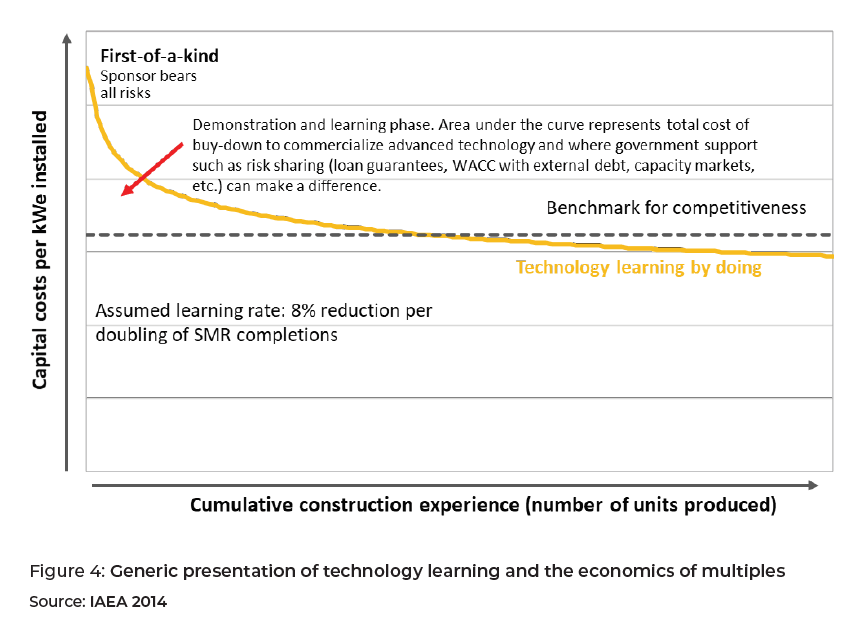
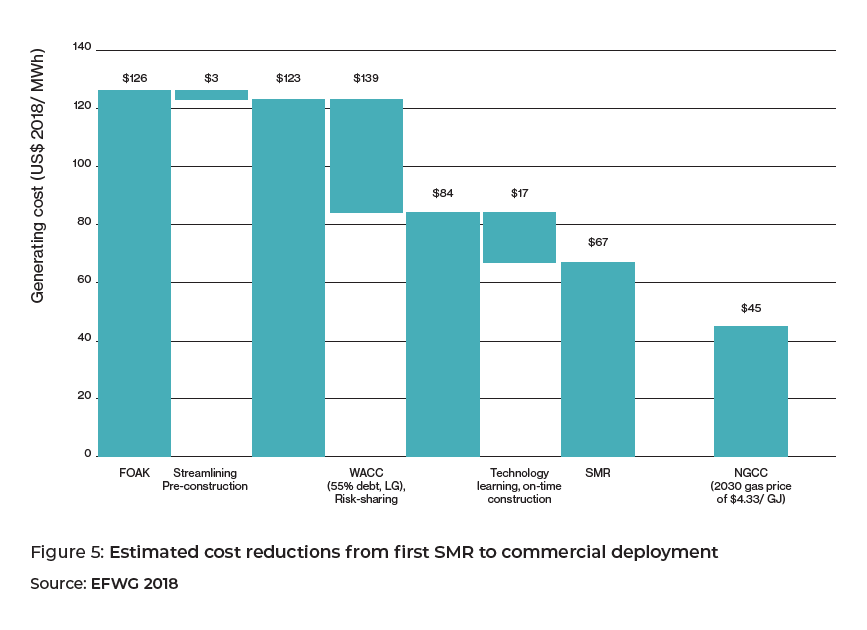
Figure 5. Estimated decline in LCOE for a 300-MWe SMR due to improved financing conditions. The figure illustrates improved financing related to the weighted cost of capital (WACC), loan guarantees (LG), required returns on investment, shorter construction times, and learning. The final bar compares the estimated cost for a natural gas combined cycle (NGCC) plant, with and without carbon costs. All costs are noted at 2018 US dollars and exchange rates.
Key Recommendations
1. All G20 countries must endorse nuclear energy to meet climate targets by:
a. supporting license extensions for existing plants, the construction of new plants, and the development of advanced technologies, including small modular reactors (SMRs),
b. supporting research, pilot projects, and educational activities to heighten the recognition of nuclear energy’s positive contributions, especially in mitigating climate change, and
c. de-politicizing nuclear energy by endorsing global norms, policies, and practices to manage the sector.
2. All G20 countries are urged to share best practices with all countries and encourage nuclear newcomers to follow the International Atomic Energy Agency’s (IAEA) “Milestones” approach, as well as:
a. endorsing multi-national repository initiatives and fuel take-back approaches to spent fuel management, as both are particularly beneficial to newcomer countries, and
b. assisting in mobilizing finance, technology transfers, and capacity-building activities in developing countries.
3. All G20 countries should work toward:
a. strengthening international regulatory and safety regimes by empowering the IAEA to gradually assume the role of international regulator, and
b. supporting standardized licensing criteria for SMRs and building on recent IAEA and Organisation for Economic Co-Operation and Development (OECD) analyses and recommendations.
4. All G20 countries must support the development of advanced SMRs and associated fuel cycles while upholding high standards of safety, security, spent nuclear fuel disposal, and non-proliferation by:
a. supporting research, development, and demonstration activities toward early SMR commercialization, and
b. developing user requirements to focus commercialization efforts on a manageable fraction of the more than 50 SMR designs currently under development by building on recent IAEA and OECD analyses and recommendations.
Disclaimer
This policy brief was developed and written by the authors and has undergone a peer review process. The views and opinions expressed in this policy brief are those of the authors and do not necessarily reflect the official policy or position of the authors’ organizations or the T20 Secretariat.
References
Economic and Finance Working Group. 2018. “SMR roadmap.” Accessed July 31, 2020. https://smrroadmap.ca/wp-content/uploads/2018/12/Economics-Finance-WG.pdf.
European Commission. 2020. “Regulation of the European Parliament and of
the Council establishing the Just Transition Fund,” European Commission (EC)COM/2020/22 final, Brussels, 14 January 2020. Accessed July 31, 2020. https://eur-lex.europa.eu/legal-content/EN/TXT/HTML/?uri=CELEX:52020PC0022&from=EN
Intergovernmental Panel on Climate Change. 2014. “Climate Change 2014: Mitigation of Climate Change.” In Contribution of Working Group III to the Fifth Assessment Report of the Intergovernmental Panel on Climate Change, edited by O. Edenhofer, R. Pichs-Madruga, Y. Sokona, E. Farahani, S. Kadner, K. Seyboth, A. Adler, I. Baum, S. Brunner, P. Eickemeier, B. Kriemann, J. Savolainen, S. Schlömer, C. von Stechow, T. Zwickel, and J.C. Minx. Cambridge, UK: Cambridge University Press.
Intergovernmental Panel on Climate Change. 2018. “Global Warming of 1.5°C: An IPCC Special Report on the Impacts of Global Warming of 1.5°C above Pre-Industrial Levels and Related Global Greenhouse Gas Emission Pathways, in the Context of Strengthening the Global Response to the Threat of Climate Change, Sustainable Development, and Efforts to Eradicate Poverty.” Accessed July 31, 2020. https://www.ipcc.ch/site/assets/uploads/sites/2/2019/06/SR15_Full_Report_High_Res.pdf
International Atomic Energy Agency. 1997. “Joint convention on the safety of spent fuel management and on the safety of radioactive waste management.” Accessed July 31, 2020. https://www.iaea.org/sites/default/files/infcirc546.pdf
International Atomic Energy Agency. 2014. “Approaches for Assessing the Economic Competitiveness of Small and Medium Sized Reactors.” In IAEA Nuclear Energy Series No. NP-T-3.7. Vienna, Austria: International Atomic Energy Agency.
International Atomic Energy Agency. 2015. “Milestones in the Development of a National Infrastructure for Nuclear Power.” In IAEA Nuclear Energy Series No NG-G-3.1, Rev 1; STI/PUB/1704. Vienna, Austria: International Atomic Energy Agency.
International Atomic Energy Agency. 2016. Advances in Small Modular Reactor Technology Developments, 2016 Edition. A Supplement to: IAEA Advanced Reactors Information System (ARIS). Vienna, Austria: International Atomic Energy Agency. Accessed July 31, 2020. https://aris.iaea.org/Publications/SMR-Book_2016.pdf
International Atomic Energy Agency. 2018. Advances in Small Modular Reactor Technology Developments, 2018 Edition. A Supplement to: IAEA Advanced Reactors Information System (ARIS). Vienna, Austria: International Atomic Energy Agency.
International Atomic Energy Agency. 2020a. “Power reactor information system (PRIS).” Accessed July 31, 2020. https://pris.iaea.org/pris
International Atomic Energy Agency. 2020b. “Small modular reactors.” Accessed March 14, 2020. https://www.iaea.org/topics/small-modular-reactors
International Energy Agency. 2019a. “World Energy Balances 2019.” Accessed July 31, 2020. https://www.iea.org/reports/world-energy-balances-2019
International Energy Agency. 2019b. “Nuclear Power in a Clean Energy System.” Accessed July 31, 2020. https://www.iea.org/reports/nuclear-power-in-a-cleanenergy-system
Partanen, Rauli. 2018. “The Most Dangerous Nuclear Power Plant.” Accessed July 31, 2020. https://www.energy-reporters.com/opinion/the-most-dangerous-nuclearpower-plant








